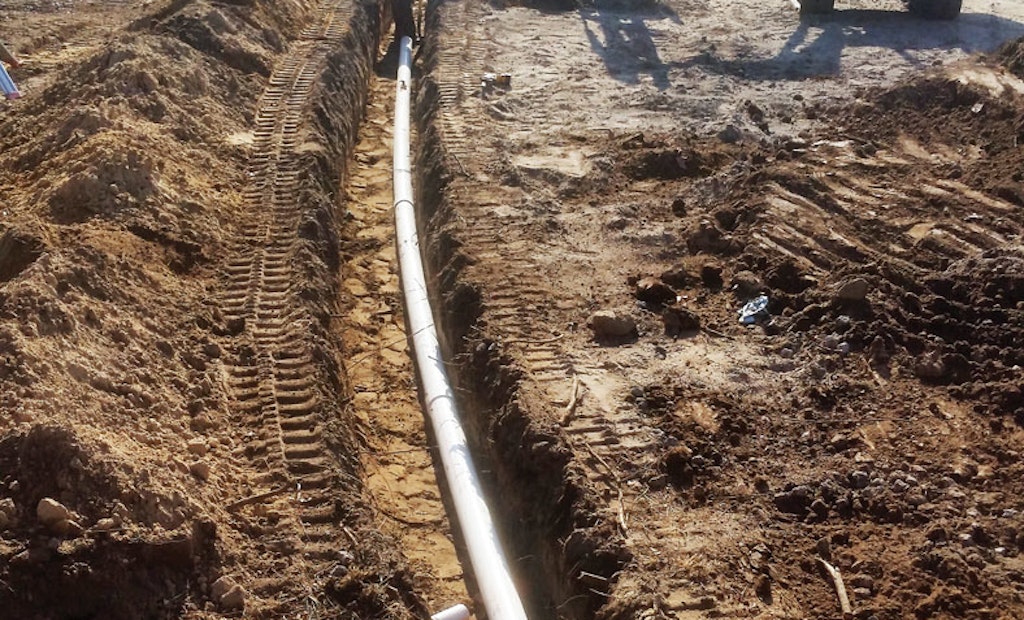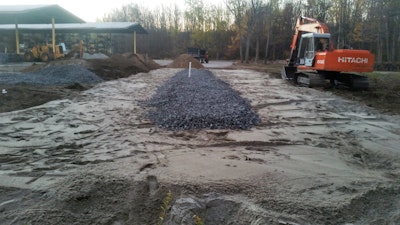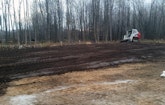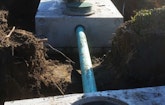
Blake Johnson and Cody Houseknecht lay a wastewater line to the mound system with the aid of the Takeuchi mini-excavator. Pipes were buried only about 2 feet below grade to keep the tanks as far above the high water table as possible.
Land can be marshy around lakes. Combine that with a restricted site and you have the problem that Sunset Septic & Excavating was called in to solve in Michigan City, Indiana.
The wetland was about 2 miles from the shore of Lake Michigan and covered between 50 and 100 acres, says Jon Houseknecht, who owns Sunset Septic & Excavating with his wife, Gale. At one time, the property was the site of a lumberyard for the 84 Lumber store. The new owner wanted to convert the property into the base for a trucking operation. He built an octagonal office building from a kit, and Sunset Septic & Excavating connected wastewater lines to the building. The shop also had new bathrooms constructed by the owner.
The designer had few choices about where to site the mound absorption system. There was the large wetland, which ended up being 210 feet from the mound system and much closer to the tanks, and there was a well on the property that came with its own 100-foot setback zone.
Moving the effluent
Wastewater exits the office building in a 6-inch SDR pipe that runs about 340 feet and discharges into a 1,250-gallon, single-compartment concrete tank from Farmer Tank of Elkhart. This tank settles debris and provides primary treatment.
A 4-inch SDR pipe collects wastewater from the shop and runs about 60 feet before connecting with the 6-inch line from the office.
A Polylok Inc. / Zabel PL-525 filter removes debris before the water flows to a second 1,250-gallon concrete tank, also from Farmer Tank, which acts as the pump chamber for the mound. A BE270 pump from Zoeller Pump sends water through about 210 feet of 2-inch Schedule 40 pipe to the mound. Because of the distance to the mound, an electrician was called in to run a 240-volt power line for the system.
In the mound, the 2-inch line enters a four-line manifold. There are no valves. The manifold splits the flow into two 1 1/2-inch lines, and each of those divides into a pair of 1 1/4-inch line that doses the mound. Each dose line is 30 feet long for a total of 120 feet of line.
The mound covers about 30 by 100 feet. It consists of 24 inches of sand laid at grade and covered with a layer of geotextile fabric. Next is 6 inches of septic slag below the pipes, then 2 inches of slag around the pipes and 2 inches on top. About 6 inches of sand and about 6 inches of topsoil were spread on top of the mound.
Pumping is controlled by floats. Sunset Septic & Excavating installed an AlarmBot system from CSI Controls. Houseknecht found the system at the Water & Wastewater Equipment, Treatment & Transport (WWETT) Show and appreciated its plug-and-play simplicity.
Attention to detail
When the job was finished, the crew covered the mound with an anti-erosion mat like those used by highway crews, added some spikes to hold it in place, and sprinkled grass seed on the soil to provide cover.
The company used a Takeuchi 125 mini-excavator, Takeuchi 126 skid-steer and Hitachi 120 excavator to complete the earthwork.
Heavier SDR pipe was used because of traffic on the site. The Sunset Septic & Excavating crew encased the 4-inch shop line with Bubble Wrap insulation and put that combination inside a 6-inch pipe. They did the same with the 2-inch line feeding the mound. It was wrapped with foil-faced insulation, and the combination was placed inside a jacket of 4-inch Schedule 40 PVC.
Pipes were buried only about 2 feet below grade to keep the tanks as high as possible above the water table.
“The line was shallow, and we knew we would have heavy traffic on top of it because of the driveway. We were also worried about freezing,” Houseknecht says.
Septic slag is a product common to this part of Indiana but not the rest of the country. It is a byproduct of the process that converts iron ore into steel, Houseknecht says. Slag looks like volcanic rock, with many pores and many sites for bacteria to attach. The company selling it washes and sizes the rock for use in wastewater applications.
Although river rock is typically used in installations, Michigan City is only about 40 miles from the steel-producing city of Gary. Given the cost of hauling other alternatives to the site, septic slag is a more economical solution, Houseknecht says.
Because the site had been previously occupied, there was a grease trap in place collecting wastewater from the shop. Sunset Septic & Excavating technicians took samples to make sure the trap was doing its job and would not feed high-strength shop waste into the system. That could always be undone by the customer’s use, but not in this case.
“The owner of the property is a strong environmentalist, so he has instructed his guys to be careful about what they pour down the drain,” Houseknecht says.
Securing the tanks
The high water table was a challenge during construction. The crew had to do some pumping to keep the excavations dry during construction. To keep the tanks in place, Sunset Septic & Excavating technicians first placed the bottom half of a tank in its hole and poured in water. Then they applied the seal and put on the top half of the tank.
“Before we left for that evening, we set our excavator bucket on top of the concrete tank to make sure it didn’t shift before we backfilled it,” Houseknecht says.
With the job complete, the trucking firm has a business base that will not harm the fragile lakeshore ecosystem where it settled.









